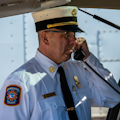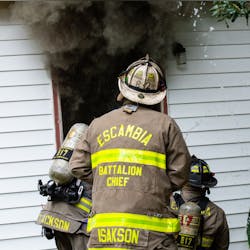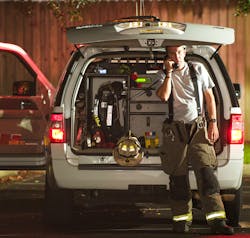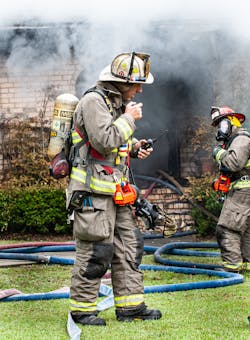Fireground command dates back decades, and the different styles are too many to list in this article. However, all fireground commanders should understand the incident command system (ICS) and the National Incident Management System (NIMS) as well as the types of command that are necessary for fires and what the majority of the fire service sees weekly, if not daily, in terms of commanding fires and daily emergencies.
Origins of the ICS
My experience with the ICS/fireground command dates back to the late 80s, when my father was instituting it in Santa Rosa County, FL. He had been attending the National Fire Academy for a few years and slowly was getting buy-in from local fire departments regarding a more controlled and professional way of managing the fireground and other multicompany/multi-agency incidents. He also was instituting command post locations/defining where the incident commander (IC) and command post would be located for all who were on-scene and responding companies. He actually built the first command box that I saw and put it in the back of the camper shell that he had on his pickup. This was beyond anything that was being done in northwest Florida. The box was like the boxes that are common today, including laminated command sheets that he brought back from the National Fire Academy. I still have those laminated command sheets and continue to use them today.
He had a 100-watt mobile radio that was mounted in the box, a green IC light to place on top of the camper shell to signify “Command Post” and other command post support items, which grew as time went on.
Up until this time, there was no system or standard ICS in place nor concepts that pertained to the determination of command location at incidents. Rarely did the senior officer even designate himself or herself as IC with the command designation of street name or business name. Often, you didn’t know who was in command nor that person’s location as the senior official who had responsibility for giving strategic and tactical objectives, to mitigate the incident as safely as possible.
What complicated the emergency even more was the lack of portable radios. Only officers had portable radios, and this was before the radio technology that we have today. Hopefully, today, most fire departments have a portable radio for every riding assignment/person who operates on the fireground and/or at the emergency incident.
As a young firefighter, it was very stressful and confusing to not always know who was in charge and to not have tactical assignments known by everyone who was on the fireground. Sometimes, your assignment even changed based on who you ran into while operating, because there was a lack of command and control, with few radios to communicate the strategic objectives backed up by specific tactical assignments.
This experience showed me the importance of not only a strong ICS but of strong command presence backup with clear and precise strategic and tactical objectives to mitigate the incident.
No one command style or command location fits all incidents or fire departments. Departments vary so much, from the response area and the types of incidents that they have, to the staffing and experiences that will be used to control the incident. A large urban department frequently might handle mid- and high-rise fires with properly staffed engine and ladder companies. The responding chiefs could be assisted by a chief’s aide/driver. Multiple chiefs most likely respond to these incidents and help to build a command team.
These urban environments usually are very congested and force the command post to be located in the street or, possibly, in the fire building lobby.
A suburban or rural department might respond to a private dwelling fire only with a driver and, maybe, only one chief. Such an incident might allow for the command post to be positioned across the street or even the front yard of the fire building.
With the fire service having such a diverse response model, we each must evaluate our potential incidents responses, what we frequently respond to and the staffing that’s available for these incidents. This helps to build a realistic command system that’s based on your area and not something that’s designed for a totally different department that responds with different staffing levels and experiences and different types of buildings in the community.
Tactical command
With my experiences as a young firefighter and the past 17 years as a battalion chief in a metro county fire department, I slowly have built my command style and use what I refer to as strategic-to-tactical command. It’s based on where the incident is within my county, the staffing that responds to the incident, the incident size and my arrival sequence with the responding fire companies. If I arrive first to a bread-and-butter fire in a private dwelling, I will use tactical command. This gets me out of the chief’s buggy, dressed, and involved in a more up close and personal size-up, which assists in not only managing the incident but in me getting personally involved in the mitigation of the incident.
A recent example of tactical command that saved the life of a 20-year-old woman in Cascade, MI, was when Fire Chief Adam Magers arrived first at a working fire at a two-story private dwelling. Magers positioned his vehicle and got out to get a better size-up. He went to the front door and opened it to evaluate fire size and location before the arrival of fire companies that were clearing off of other incidents. When he opened the door and confirmed a working fire on the second floor, he heard a cough. He made a rapid decision to hold his breath and rescue the trapped, unconscious, 20-year-old occupant. (She was released the following day from the hospital.) Magers’ decision to exit his vehicle based on arrival sequence and type of fire saved a woman’s life. If he stayed in his vehicle and/or even just stayed across the street, she most likely would have been subsumed by the fire.
Shortly after Magers removed the woman and before the arrival of the first fire company, the fire rapidly intensified. Tactical command has the fireground commander dressed out in bunker gear and in a position to see as much of the building/incident as possible. This style is great for lower-staffed and first-arriving chiefs who can make a difference physically before adequate staffing arrives.
Today’s fires burn faster than ever before. We must count seconds in relation to fire growth and survivability of trapped occupants. Thirty years ago, we had as much as 30 minutes until flashover; today, we might have only 3–6 minutes. With this, more than ever before, we need six firefighters operating on the fireground in the first six minutes to save trapped occupants. In my May 2021 column, “People Before Water” (firehouse.com/21217485), I discussed getting the first two fire companies straight into the scene to have sufficient staffing to perform fire attack and search simultaneously. When the IC/fireground commander is one of the first arriving firefighters, that person must evaluate whether a difference can be made by taking action physically while still properly managing the incident. This isn’t to say that the IC/fireground commander should gear up and get involved every time. There will be times that person arrives first and should establish a strategic command post and style of command.
Strategic command is a more complex style of command and closer to the nationally accepted command style: The IC stays in the vehicle and/or stands at the rear of a command vehicle. The command post is designated in a specific location and marked by a certain vehicle, command center, flag or light and is known by all who operate at the incident. This is very important at a large, complex incident that possibly will go beyond a first-alarm assignment and for which there’s plenty of resources to handle the incident.
The strategic command style has better fireground radio communications, better tracking of assignments and the capability to grow with the incident. However, the strategic command style isn’t prudent in the early stages of what should be a bread-and-butter fire that requires immediate action to save lives and property.
Recently, I arrived at a large commercial building fire after multiple engine companies and a ladder company already were on scene operating and established a sustained water supply. I positioned my chief’s buggy in a location where I could see most of the fire building through the windshield and assumed command and established a strategic command post location. I didn’t get out of my vehicle until nearly an hour had passed. I was able to see the fire building, the majority of the companies that were operating on scene and the success that these companies were having with the tactics that they deployed. This gave me a climate-controlled, noise-controlled command post that allowed me to use the vehicle-mounted mobile radio. I used my portable command board that I carry up front between the driver’s seat and center console.
My assuming command and my location were announced over the radio. Once I assumed command and without an additional chief officer on scene, I assigned one of the first-arriving officers as safety/operations officer, because I wasn’t getting out of the vehicle. This also empowered this officer to think bigger and more as a strategic officer versus a tactical officer. Command location and style are important, but fireground commanders also must have numerous officers assisting with managing all aspects of the incident.
Varying per incident
So, whether you start with a strategic or tactical command style/mode, there’s more than just sitting in a vehicle, standing at the back of a command vehicle or standing in the front yard of the fire building. The command location and style must fit the incident, to provide the best outcome for life-safety of both civilians and firefighters, while still placing property as a second priority.
It takes time to learn when, where and how to command an incident for the best and safest outcome. Experience matters, and being flexible is critical.
About the Author

Curt Isakson
Curt “Ike” Isakson is a 30-plus-year veteran of the fire service. He worked for Escambia County, FL, Fire Rescue for 25 years. Isakson previously worked nine years for the Pensacola, FL, Fire Department, where he was assigned as a company officer on Heavy Rescue 31. His fire service experience started at a young age as a junior firefighter with the Midway, FL, Fire District; he rose through the ranks to captain. Isakson's identification of the need for a series of special-interest fire conferences spawned the development of County Fire Tactics, which covers officer development, command officers, water on fire, high-rise operations, and leadership and tactics.


